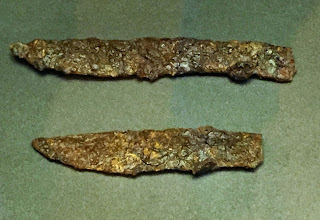Carol and Roger have passed this sign on the outskirts of Pienza innumerable times.
We had always assumed it was one of the hundreds...perhaps thousands...of archeological sites in Italy that would someday be excavated, once the backlog of excavation sites was whittled down to a manageable number.
As is usual with assumptions, we were wrong.
All it took was a trip to the Museo Etrusco (Etruscan Museum) in Chiusi to straighten us out.
Who were the Etruscans?
 |
| courtesy: Wikipedia |
Roman legend says that Aeneas, a hero of the Trojan side of the Trojan War...pictured here carrying his father out of Troy just ahead of Greek looters, abandoned Troy with a handful of followers and settled in what today is central Italy.
His descendants became known as the Etruscans and established a string of settlements in Italy well before the founding of Rome.
(See our blog post from April 2014, "Before the Romans...")
The Etruscans chose Chiusi for settlement because it was the place where the Val di Chiana and the Val d' Orcia came together.
The Etruscan presence around Chiusi was never a city, but rather several dozen small hamlets.
The map at the left shows all the excavated Etruscan sites within about 5 km of the present city.
The oldest artifacts from Pienza (or excavations close by) are these bronze spear heads, which date to roughly the year 1,000 BCE.
That's about as far back as anybody has been able to place Etruscan settlements in this part of Italy.
Some of the other Bronze Age utensils include these kitchen tools.
Note the cheese grater in the lower left corner. Not that much has changed in the past 3,000 years.
The museum is loaded with ancient ceramics.
This piece at the right came from Pienza (or nearby). It's estimated to be 2,600 years old.
The ceramics in the museum tell a fascinating story of economic development.
In the 7th Century BCE, Etruscan trade with the then-known world exploded. The map at the left shows where artifacts in the museum came from...not only Greece and its settlements in Sicily, but also Carthage in North Africa, Massalia (present-day Marseilles), and the Greek colonies on the Black Sea.
The best example of a distant product is this funerary piece carved out of ivory. There were no elephants native to the Italian peninsula at this time, so the ivory likely came from North Africa.
Most of the goods from overseas came to Chiusi through the port of Vulci...100 km to the west.
(See our blog post on Vulci, "Three Times Abandoned," from September 2017)
Enough digression! Back to the story of the ceramics.
With the expansion of trade, the Etruscans brought in ceramics from Greece (this pot shows Odysseus' son about to leave home to search for his father, now missing almost 20 years).
Soon, Etruscan craftsmen began copying Greek designs but putting their own legends and myths on the ceramics.
And finally, some Etruscan "modernists" asked why they should copy Greek styles, and came up with designs of their own.
P.S.: Not all the items in the museum were utilitarian. Many were pieces found in Etruscan tombs and stood out for their beauty.














No comments:
Post a Comment